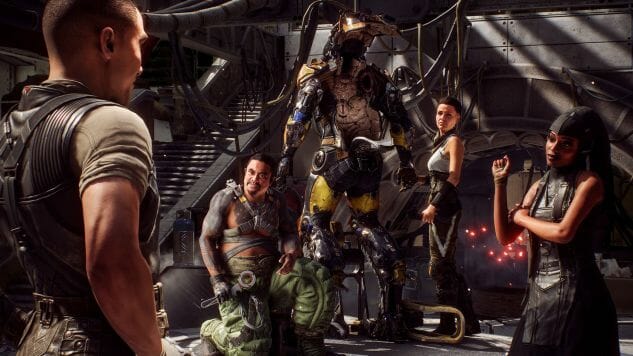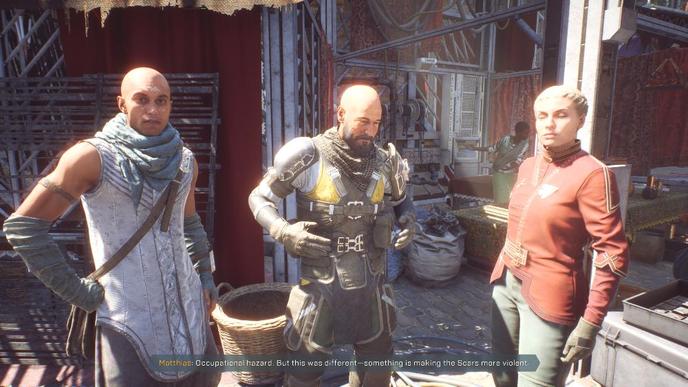Anthem Marks New Territory for Bioware, And Even After Playing It We Aren’t Entirely Sure What to Expect
Games Features Anthem
Earlier last year, I wrote that I was skeptical of Bioware tackling a small-squad online shooter MMO (a bunch of words that basically mean “a game like Destiny”) because it isn’t playing to their strengths as a studio. After getting some hands-on time with the game at a press event at Electronic Arts’ offices in San Francisco, I’m somehow both reassured and more worried about the fate of the game.
Anthem is certainly doing some interesting things with the type of game that it is. It’s got a gorgeously designed world, lush in greens and blues and exquisitely high-detail natural environments. Flying around enemies or from waypoint-to-waypoint feels just as fun the 50th time as it does the first time, swooping around the battlefield or around the map with a quick learning curve. It’s the flight mechanic that seems to be at the core of Anthem’s design mentality, and the game’s success will likely live and die by how the rest of the game is modeled around it.
Javelins, Anthem’s name for the superhuman exosuits piloted by Freelancers, come in four classes, and while each controls similarly (including having a double jump, flying and hovering modes) each is specialized toward a different type of combat. The Colossus is the largest, bulkiest and most armored Javelin; the Storm is built around ranged elemental attacks and lacks the armor of its other Javelin brethren; the Ranger is the most solid all-around Javelin but lacks specialization toward any specific type of play; and the Interceptor is the lightest and fastest Javelin with a penchant for high-speed gravity-defying melee attacks.
When Anthem shines, it is in its team combat, where you can feel both tactically engaged in teamwork and communication while simultaneously working on a moment-to-moment level to dispatch enemies and position yourself within the battlefield—including vertically, thanks to Javelin’s hover and flight abilities. Playing as a Storm Javelin and being able to perch myself high above the arena while slinging fireballs or lightning strikes down at enemies was just as satisfying as being a Colossus and shield-slamming enemies in-between firing off volleys of mortars.
Each Javelin includes two weapon slots, two ability slots, a number of Component slots (usually stat bonuses or trade-offs), as well as extensive visual customization options. While some of these slots are locked to certain player levels, Javelins feel able to be re-specialized toward different roles relatively easily, if you can get used to the often-confusing UI.
All of the above are the notes that I genuinely enjoyed while playing the early version of the game, and all of which make the moments where Anthem’s combat stumbles feel all the more disappointing. While aerial maneuverability was a joy, a number of missions I played threw the player’s team into tight, small environments that robbed the Javelins of some of their most enjoyable abilities. It wasn’t all the missions, and many liberally used “large underground caves” as settings to allow for aerial movement in confined areas, but more than a couple questlines involved piloting the slow-turning Javelins in smaller arenas.
The majority of Anthem’s combat might feel remarkably similar to anyone who played Mass Effect 3. It’s certainly been polished since then, and Javelin pilots move much more responsively than Commander Shepard ever did, but I found Anthem’s weaponry to have an unfortunately similar lack of punch. Shooting a heavy rifle just never felt that satisfying, and unclear or unorthodox enemy weak-spots meant that getting a headshot was often more complicated than expected. Enemies (at least in this iteration) didn’t have much stun or knockdown (with a few notable exceptions) and the early-game and mid-game sections showed a pretty slim variety of enemies.
Most missions felt disappointingly repetitive, with a point to defend against waves of enemies until a bar fills up, followed by moving to another location and doing the same thing. It wasn’t terrible by any means, but with the limited variety of loot and unique items in the sections available to me, it felt more bland than I expected. This could be something that is improved in the full game, however, when more loot options and developed missions are available. A particular standout was a mid-game mission that included a genuinely fun multiplayer puzzle section, that had my team throwing guesses out over the mic as we tried to suss out the right order of a coded lock from environmental clues—if Anthem has more moments like that, consider me sold.
From a narrative perspective, Anthem has some big shoes to fill. After Bioware’s announcement that the game would not include romantic options, I was coming into Anthem expecting only the most barebones of expositional dialogue and stock characters, but I was pleasantly surprised at what I got. Characters, even in the limited time that I got with them, are well-written and interesting, with only a few moments of overly-precious dialogue.
The world of Anthem is big, ancient, and filled with capital-L Lore. There’s not really an optimal way to introduce players to a world like that, but between a number of cinematics and a lot of characters informing me about the entire recent history of the human city of Fort Tarsis, I found myself longing for the straightforwardness of Mass Effect’s opening texts. Luckily, in later sections of the game the dialogue and writing felt a lot more relaxed and naturalistic, from in-mission text to free-roaming conversations around Fort Tarsis. It still left me feeling somewhat empty, though, as the lack of non-player crewmembers meant that a core component of previous Bioware games—the interactions between crewmembers during missions—was just not going to be a part of Anthem.
Maybe that’s okay. The game that I would have wanted Anthem to be might not be the one coming out, and I’m willing to give this one a shot after having some hands-on time with it. It’s not perfect, and some of the multiplayer drop-in/drop-out mechanics still feel worryingly clunky this close to release (to say nothing of the various technical bugs I encountered, which I’m giving some leeway to as the game is still in a pre-beta state), but Anthem is stronger in many ways than I expected it to be. I just hope they can pull it all together by the time of release.
Anthem is scheduled to come out on Feb. 22 for PC, PlayStation 4 and Xbox One.
Dante Douglas is a writer, poet and game developer. You can find him on Twitter at @videodante.

